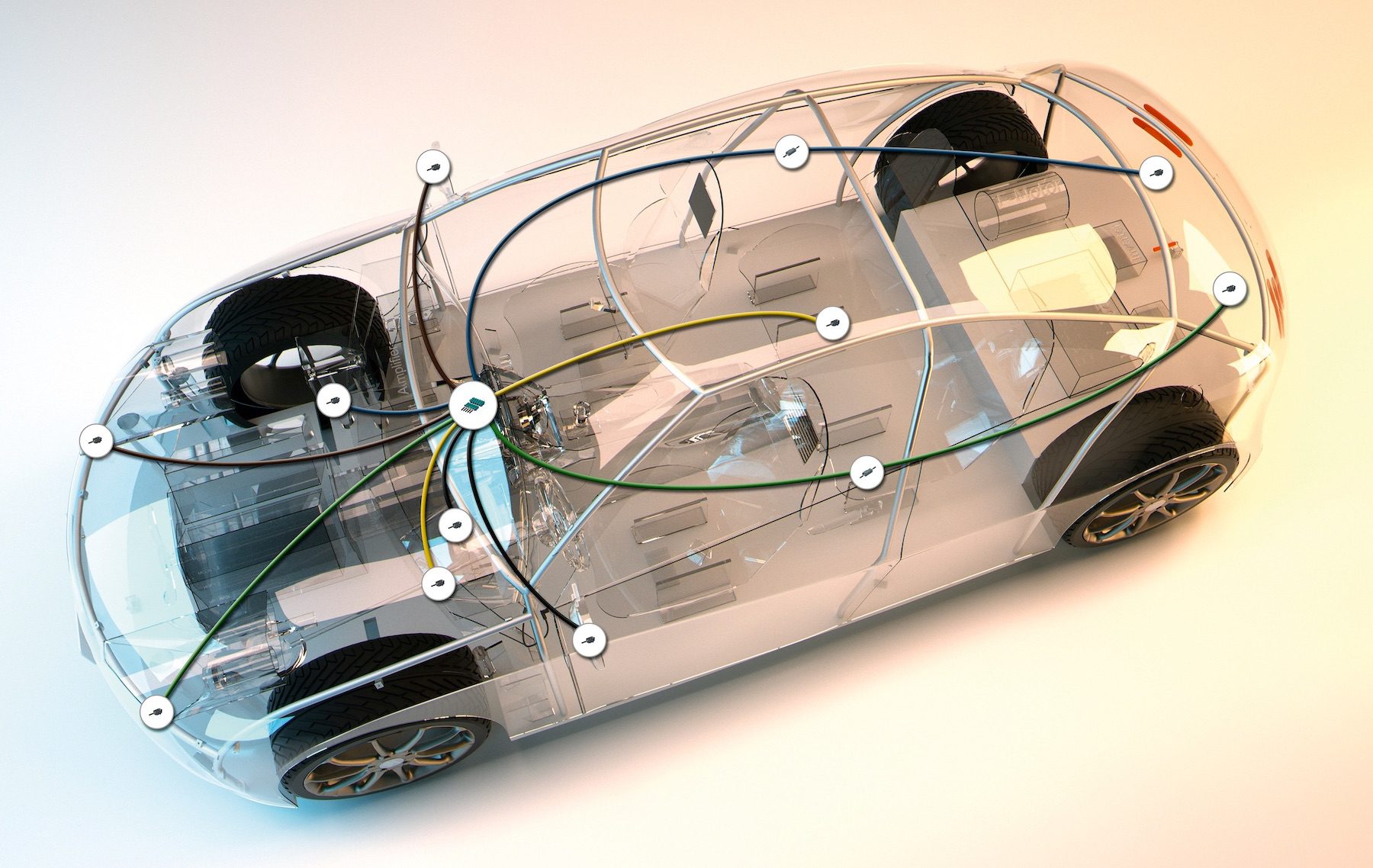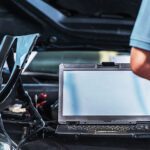Automotive Ethernet is a Key Enabler for Connected Cars
Automotive Ethernet interconnect solutions need to be miniaturized, lightweight, modular, optimized for high-speed automotive systems, and compatible with automated assembly processes.

Connectivity is enabling safer, greener, and more enjoyable driving experiences. As connected car technologies within vehicles continues to rise in support of these features, so too does the amount of data that has to be securely transmitted, including large data packages that require high-bandwidth capabilities.
Automotive Ethernet offers the best benefit-cost ratio for handling high-speed, high-bandwidth automotive data transmission. Smart, scalable connectivity solutions must also provide the flexibility, economy, and performance required for various EMC levels; withstand environmental hazards, including heat, dirt, moisture, and vibration; and enable easy integration into systems with stringent space and weight requirements.
Connected Cars Drive Growth in the Automotive Industry
Three global megatrends — connectivity, autonomous driving, and electrification — are transforming cars into the ultimate smart devices. Connectivity is an essential part of all three trends. In EVs, networking occurs within cars. In autonomous vehicles, networking also occurs between cars and other vehicles, the cloud, and smart city and intelligent transportation systems (ITS) infrastructure.
Automotive connectivity started with global positioning system (GPS) technologies, satellite radios, Bluetooth, and Wi-Fi connectivity. The next step in automotive connectivity leverages smartphone apps to identify parking spaces, pay tolls, or communicate the charging status of an EV. The whole point of autonomous vehicles is to free drivers from decision-making tasks to improve safety and efficiency. Autonomous vehicles require access to real-time information about current road conditions, weather, speed limits, and other factors. Energy use monitoring is especially crucial for EVs, since their range is influenced by temperature, driving style, route topography, and the availability of charging stations.

Automotive Ethernet connectivity extends throughout vehicles, providing a wide range of critical systems and devices with high-speed data.
Advanced driver-assistance systems (ADAS) like automatic braking systems are gradually developing into autonomous driving functions. Sensor fusion (e.g., the integration of camera, radar, and lidar technologies) delivers an accurate list of static and dynamic objects, applicable rules and limitations (e.g., lane markings and traffic signs), and accessible trajectories.
Many in-vehicle systems will deliver even more timely data about incidents and other variables as vehicle-to-everything (V2X) technology expands. The V2X data transmitted by individual vehicles (e.g., “Apply brakes; accident ahead.”) is uploaded to the cloud, where it will be processed, refined, and, upon validation, shared with other vehicles. This kind of connectivity will effectively establish swarm intelligence that can be used to turn traffic into an intelligent system capable of regulating itself to a degree, although neural networks and artificial intelligence will ensure accurate analyses of complex traffic scenarios.
Another market driver, cyber security, will be necessary to protect connected cars from hacking and data theft. To stay ahead of hackers, vehicles will need to be compatible with software-over-the-air (SOTA) distribution to enable automatic updates such as software patches designed to eliminate vulnerabilities, which will generate even more data traffic within and between vehicles.
Connected Car Requirements
Bandwidth: At the very core of in-vehicle networking and connectivity is the physical layer of networking — the interconnection system and cabling harness. Existing vehicle bus standards such as CAN, LIN, FlexRay, and MOST were developed in response to specific requirements and designed to strike an optimal balance between cost and performance. Automotive Ethernet is expected to account for a steadily growing share of the in-vehicle networking. Governed by standards including IEEE 100BASE-T1 (IEEE802.3bw) for data transfer speeds up to 100 Mb/s at up to 66 MHz and IEEE 1000BASE-T1 (IEEE802.3bp) for data transfer speeds up to 1Gb/s at up to 600 MHz, Automotive Ethernet offers the bandwidth necessary to transmit increasing volumes of inter- and intra-car data. Its simpler cabling structure also avoids the downsides of optical fiber networks like MOST. In the near future, cars will likely have between five and 15 Automotive Ethernet lines rated for 100 Mb/s and up to five lines rated for 1 Gb/s.
Flexibility: Some electrical architectures use more local intelligence (e.g., distributed over various engine control units [ECUs] or sensors), while others opt for a centralized architecture with more computing power in fewer but larger domain ECUs. Electromagnetic compatibility (EMC) is another challenge. Some applications require a higher level of shielding while others work well with a simple unshielded cable. Shielding requirements translate into different cable types at different price points, and many cable types require specific types of connectors.
Automotive-Grade Robustness: Vibration, impacts, temperature extremes, moisture, aggressive fluids, and voltage fluctuations in on-board electrical infrastructure pose tough challenges for managing high-signal-integrity data flows in vehicles. In addition to being robust, cabling harnesses must be easy to install and compact and lightweight.
Automotive Ethernet Interconnect Requirements
The market for interconnection systems for IEEE Automotive Ethernet networking requires close collaboration among manufacturers, suppliers, and end-customers to ensure that solutions achieve performance, ruggedness, reliability, size, weight, cost, quality, flexibility, and ease of use goals.

TE Connectivity’s MATEnet Modular and Scalable Connectors and Cable Assemblies provide cost-efficient, high-speed solutions for Automotive Ethernet applications. They employ robust, automotive-grade NanoMQS terminals, deliver data rates up to 1 Gb/s over UTP and STP wire, and conform to IEEE 100/1000BASE-T1. They are also compatible with PoDL (Class 3, 48V), A2B, and HDBaseT protocols.
Performance and Reliability: Automotive Ethernet solutions should enable networking architectures to distribute growing data volumes at very low latencies. Key applications include ADAS sensors, 360° camera systems, telematics units that provide data traffic to the head unit, onboard diagnostics, infotainment, and domain architecture computes. These systems require reliable connectivity to capture and act on data from multiple sources.
The connectors employed in these networks must also be designed to ruggedly withstand vibration and provide outstanding performance despite hazards including mud, dust, humidity, water immersion, and temperature extremes. Connector solutions used in heavy-duty equipment for mining, agriculture, military, and marine applications could easily find new uses within Automotive Ethernet networks. Unsealed connectors that are designed for severity level 1 vibration requirements can withstand 2g random vibration and 30g shock, while sealed connectors designed for severity level 2 vibration requirements can withstand 3g random vibration and 30g shock.
Design Considerations: Automotive Ethernet interconnect solutions need to be miniaturized, lightweight, and modular, optimized for high-speed automotive systems, and compatible with automated assembly processes.
Miniaturization – One key consideration is the industry’s need to miniaturize connectors within subsystem modules to save space. Leading Automotive Ethernet interconnect systems incorporate miniaturized terminals (i.e., contacts), connectors, and headers to reduce the density of electronics in the vehicle and leave more space for application electronics. In general, shielded systems have greater miniaturization capabilities than unshielded systems, as manufacturers can place multiple ports close together. For unshielded connectors, channel separation can be realized when using metal sheets for multiport connections.
Lightweighting –Lightweighting involves miniaturized connector solutions with lighter-weight materials. For example, unshielded twisted-pair connectors are lighter than shielded high-speed connectors due to the latter’s employment of metal shield components. Similarly, devices that can use traditional connectors made from plastic are lighter than those that require heavy diecast bodies for EMC designs. Smaller, lighter connectors enable OEMs to deploy more systems in the same space.
Modularity – Modular components provide the greatest design flexibility and are well-suited for use in Automotive Ethernet systems. Modular connectors can integrate several different components to achieve many different configurations, including single- and multi-port configurations for sealed, unsealed, shielded, or unshielded applications. Modular connectors could, for instance, incorporate twisted-pair (TP), unshielded twisted-pair (UTP), and shielded twisted-pair (STP) components within a single connector frame or molded body.

The exploded view of a two-position MATEnet connector from TE Connectivity (top) shows the elements of the interconnect system’s core module. Examples from the MATEnet modular interconnection system portfolio (bottom) further illustrate the modularity of these Automotive Ethernet solutions.
Connector Components – High-speed connectors also have several unique design attributes. For instance, high-speed systems require shielded cables, which are heavier, more complex, and more difficult to install than unshielded cable. They also require complex termination processes, including braid and foil handling. They can, however, still use standard terminals, enabling wiring harness manufacturers to use standard crimping tools for installation and improving their ability to develop and scale industry-leading harness solutions for global automotive sales and distribution.
Automation – Another critical design consideration is compatibility with automated production processes, including automatic wire processing. Since Automotive Ethernet networks control several critical systems, every enabling component must provide automotive-grade robustness with high levels of confidence, as documented in global OEM specifications such as LV214 in Germany and USCAR2 in the U.S.

TE Connectivity’s NanoMQS receptacle contacts were developed for automotive connectors. The compact crimp terminals are designed for a 1.8mm nominal pitch, can be used to terminate very fine wires with cross-sections as small as 0.13mm2, and are fully compatible with automated processing. They are also very robust.
Testing Requirements: Manufacturers need to consider the worst-case tolerance analysis along with cable definitions, in-depth signal integrity analysis with respective board-level design and EMC, the processing requirements for cable termination, and system testing with end-customers. To help streamline this process, the Open Alliance has provided specifications for Automotive Ethernet testing. Connectors must successfully pass an array of demanding testing and validation requirements from OEMs before design-in to ensure that they’ll provide exceptional performance. For Automotive Ethernet networks, users are generally seeking 1 Gb/s transmission speeds per 1000BASE-T1 specifications with the potential to support up to 4 Gb/s to meet evolving application demands.
Achieving Business Goals: Signal integrity is paramount when it comes to applications that require high-frequency, high-bandwidth data transfer. The effort and cost required to satisfy individual Automotive Ethernet application demands are typically a product of measures integrated into both the chip and the channel (i.e., cable and connectors). Ideal solutions should provide an optimum balance between both cost curves. For example, solutions that use application-specified round cables can potentially offer an excellent cost-performance ratio because they don’t place a high burden on chip capabilities (e.g., size or power consumption) and don’t require high-end cabling, which reduces complexity in addition to materials and processing costs.
Connector manufacturers generally provide automotive OEMs with component development capabilities that include end-to-end system expertise ranging from board-level design and layout to layer stack definitions and discussions on PHY Level implications. They then collaborate with OEMs, Tier 1 manufacturers, and silicon vendors to develop related application specs, provide appropriate definitions for implementers, and draft guidance to ensure that customers use products in the proper manner. Ongoing participation in industry bodies such as the Open Alliance Special Interest Group (OpenSig) servicing Technical Committees for TC 2 (100 Mb/s) and TC 9 (1 Gb/s) can also provide helpful technical expertise and best practices as manufacturers innovate solutions.
For more information about Automotive Ethernet solutions, visit TE Connectivity online.
Like this article? Check out our other articles on Ethernet and ADAS, our Automotive Market Page, and our 2022 Article Archive.
Subscribe to our weekly e-newsletters, follow us on LinkedIn, Twitter, and Facebook, and check out our eBook archives for more applicable, expert-informed connectivity content.
- Automotive Ethernet is a Key Enabler for Connected Cars - May 31, 2022





